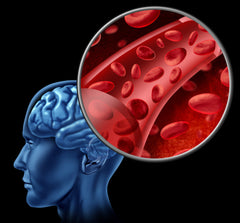
Could injecting blood from young, healthy adults into Alzheimer’s patients become a prescribed treatment sometime soon? Apparently, young mammalian blood contains compounds, specifically one called GDF11, that improve brain cell connections. These are the same connections that are destroyed by amyloid-beta deposits characteristic of Alzheimer’s disease.
Brain Preserving Compounds in Young Blood
Two studies conducted in collaboration with Harvard Stem Cell Institute and published in the journal Science, along with a third study published in Nature Medicine, concluded that compounds in blood from young subjects could improve brain cell connections and strengthen atropic (withered) muscles. Scientists injected older mice with blood from younger mice. These experiments revealed that the youthful blood boosted the number of connections between cells in the brain’s memory hub and made them stronger.1, 2 Additionally, cognitive function improved in the older mice, and older animals did as well as younger animals in tests where they had to remember how to navigate out of a swimming pool.1, 2 The likely “drug” or compound causing the improvement is the protein growth factor GDF11. This discovery means that the benefits of young blood transfusions can be manufactured in a pill, eliminating messy procedures. In a second study published in the journal Science, researchers used GDF11 from young blood to boost the strength of aging mice by up to half.3 Several media outlets quoted Professor Chris Mason, an expert in regenerative medicine from University College London, as saying, “Dracula’s power to grow stronger by drinking blood would be trivial compared to the impact of a drug discovered in blood that produced true brain rejuvenation.”
The Biochemistry of the GDF11 Compound
GDF11 stands for growth differentiation factor 11. It plays an important role in preserving the optimal muscle size for the best possible level of metabolism. It’s related to myostatin and other growth factors that have an overall negative influence on size of muscles, which can diminish in function if they become pathologically enlarged.4 The effect that GDF11 has on decreasing muscle size led scientists early last year to study its effects on older animals with enlarged hearts. Doctors joined together the circulation of animals of different ages, a procedure called heterochronic parabiosis. After four weeks of exposure to the circulation of young mice, cardiac hypertrophy in old mice dramatically regressed, accompanied by a reduction in the size of heart muscle cells. The researchers identified GDF11 as the key circulating factor causing the results.5
GDF11’s Neuromuscular Preserving Properties
A growth factor, such as GDF11, which optimizes muscle size and function, may actually have the same effect on nerve endings. The theory works like this: If a muscle pathologically enlarges, like an enlarged heart, the nerves innervating the muscle can become “stretched” and damaged. Consequently, nerve-to-nerve connections can also become damaged. The point: Fix the muscle and you’ll fix the nerve. So it’s not surprising that GDF11, which restores normal muscle size and function, would improve innervation as well. Some scientists believe that it improves nerve cell connections indirectly by improving muscle size, while others believe it has more of a direct effect on forming new nerve cell endings.6 In either case, it seems that GDF11 is about optimizing neuromuscular junctions. Could its effects also apply strictly to brain cell connections? Well, let’s go back to the original young blood injections.
GDF11 Rich Blood Improves Brain Cell Connections
In the original animal tests, young blood rich in GDF11 improved the older animals’ ability to complete mazes designed to test memory and spatial recognition. Memory and spatial recognition, by the way, are likely associated with quality brain cell connections. So we have evidence that GDF11 from young blood improves brain cell connections, at least when measured during animal maze studies. This is further supported by the fact that innervation to pathologically enlarged hearts also improves with GDF11-rich blood.
What You Need to Know
Brain cell connections can be restored! This is important because in the recent past, doctors believed that brain cell connections, once damaged, stayed damaged. Studying brain cell connections, called neuroplasticity, has opened up new avenues of research for many neurodegenerative disorders like Alzheimer’s disease and offers hope and promise for effectively treating dementias.
References:
- Science. 2014 May 9;344(6184):630-4.
- Nat Med. 2014 Jun;20(6):659-63.
- Science. 2014 May 9;344(6184): 649-52.
- Immunol Endocr Metab Agents Med Chem. 2010 Dec;10(4):217-231.
- Cell. 2013 May 9;153(4):828-39.
- Mol Cell Neurosci. 2008 Feb;37(2):247-60.
